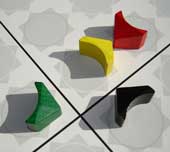


|

|
Home |
Contact |
PACRU RULE SUMMARY
MOVEMENT: You move a piece in one of three directions. Move it straight ahead, or forwards at a 45
degree angle to the direction the piece was pointing. After a move, leave the
piece pointing in the direction you've moved it. This is the only way that pieces move from tile to tile.
BORDERLAND CHANGE: When you move a piece across one or more
borders, and set your piece down in a different borderland (a border crossing)
then you replace one of the neutral tiles in this new borderland with a tile of
your colour.
POWER OF MOVEMENT: Count the tiles of your colour in the
borderland and that number is the power of movement of the piece. If there are no tiles, the power of movement
is one. You can move that particular piece any number of tiles between one and
its power of movement.
LONG MOVE: When you move your piece more than one tile (a
long move), you cannot change direction in the middle of the move. You must move in a straight line (directly
ahead, or ahead at 45 degrees). At the
end of the move leave the piece pointing in the direction you have moved it.
WHAT IS FORBIDDEN:
Except for a connection jump You
may not jump over any piece
Except for a pincer
You may not move onto a tile occupied by a piece
You may
not move onto a tile that is another player’s colour
You may
not change a tile that is occupied by a piece
CONNECTION CHANGE: When you make a long move from one tile
of your colour to another tile of your colour (a connection), and you are not
jumping any pieces, you must change all the intervening tiles to your
colour. If this connection is also a
border crossing then you must choose either to gain tiles from the connection
change or from the results of the border crossing: you cannot claim both
benefits.
CONNECTION JUMP: When you move from one tile of your colour
to another tile of your colour, you are allowed to jump any intervening
pieces. However when you make a
connection jump, you do not make a connection change and so no intervening
tiles are changed.
BORDERLAND TRANSFORMATION: When you set your piece down
having crossed a border, if there are no neutral tiles (whether occupied by a
piece or not) left in the new borderland, then you change any tile within the
borderland to your own colour.
PINCER: When a piece has a power of movement such that it
could reach a tile occupied by an opposition piece, and there are no
intervening pieces, then it is said to be attacking that piece. You can make a pincer when two or more of
your pieces are already attacking an opponent’s piece at the start of your
turn. In the pincer you remove the
opposing piece from the board, change the tile it was on to your colour, and
move one of the attacking pieces onto the tile. The pincer can be done even when the opponent’s piece is
occupying a tile of their colour.
MEETING: When you move a piece so that you have two of your
pieces both occupying tiles of your colour and directly facing each other on
adjacent tiles you have achieved a meeting. As a result of the meeting
you change any tile anywhere on the board to your own colour.
ONE MOVE - MANY ACTIONS: When you make a move involving any
one of the six special actions, the move may also involve another at the same
time (a pincer may also be a borderland change). You get the benefits of each action, except for moves which are
both borderland crossings and connections where you have to choose between the
tile benefit for the crossing and that of any connection change.
REORIENT: You can use your turn in a different way and instead
of moving one piece, you can reorient one piece. When you reorient a piece by 45 degrees, you must choose two of
your own tiles and change them back to neutral. When you reorient by 90 degrees, you must choose four of your
tiles to change back to neutral. You
can only use a turn to reorient if you have one or more pieces you could
move if you chose to: if none of your pieces can make a move from one tile to
another you are out of the game.
LOSING & WINNING: A player is out of the game if they
lose their last remaining piece. A
player is out of the game if, on their turn, none of their remaining pieces can
move from tile to tile (this is called a blocked turn). In this case all their pieces are removed
from the board. You can win the game in
any of these ways: you are the only player with piece(s) left on the board or
you reach the target number of tiles (for 2 players 42 tiles, 3 players 28, 4
players 24)